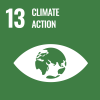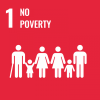More than 60,000 people, many of them internally displaced and refugees, were affected when Cyclone Gati made landfall in the northeastern part of Somalia in November 2020 following two days of heavy rains.
The tropical cyclone, equivalent to a Category 3 hurricane, was the strongest storm ever recorded in the northern Indian Ocean and wreaked unimaginable damage, dumping an incredible two years’ worth of rainfall in 72 hours.
Just two weeks later, when aid agencies surveyed the damage, the scale of the disaster revealed widespread destruction of property and livelihoods. People lost their livestock; fishing and agriculture were disrupted, wells inundated, houses destroyed, and some 42,000 people displaced.
For many, this was not the first time they were being forced to flee their homes due to natural hazards, exacerbated by climate change. Kalson, a 40-year-old Ethiopian and single mother of 13 children, knows too well what it means to depend on the weather to survive.
Originally from Kelafo, a rural town in the Somali region of Ethiopia, Kalson used to produce enough food from her small farm to feed her big family. But six years ago, reeling from persistent water scarcity and inter-clan violence, Kalson had no choice but to leave.

Consultation with communities to decide what household items they need. Photo: IOM
“My relatives encouraged me to come to Bossaso – they told me that it was much more stable, and that it had a market centre where I could find work to feed my children,” she explains.
After five days of walking through harsh terrain – a perilous journey in which many are said to have died of starvation or mauled to death by wild animals – Kalson arrived in Bossaso’s Biyo Kulel informal settlement with her children.
“We arrived with nothing,” she recalls. “We haven’t been able to find the stable work I had been told about. Sometimes we manage to find some short-term work to bring home a day’s wages.” Kalson and her 13 children now depend on well-wishers giving them “whatever change they have to spare.”
The number of people who, like Kalson, will be forced to move due to extreme weather-related events are expected to be more frequent and will do so in higher numbers in the next decades. According to the Internal Displacement Monitoring Centre, nearly 25 million people were forcibly displaced in 2019 due to natural disasters, compared to the approximately 8.6 million displaced by conflict and violence.
In 2018, more than 160 United Nations Member States endorsed the Global Compact for Safe, Orderly and Regular Migration (GCM), which emphasizes the role of climate change as a driver of forced migration, and made commitments to work together with both migrants and States to minimize risks while protecting and preserving the human dignity of migrants.
Drought in 2018. Photo: IOM/Muse Mohamed
When the climate turns against you
Kalson’s story reflects the situation of thousands of other people living in informal settlements in Somalia. They come from all around the region, escaping years of failed harvests and conflict to try their luck in the port city, famous for its exports of livestock to the Middle East, and a main gateway for migrants heading towards the Gulf.
The International Organization for Migration (IOM)estimates that there are over 100,000 migrants and displaced people in Bossaso forced to live without adequate water, food or shelter. The cyclone made it worse, sweeping away the little they had.
“We had nothing to sleep on, nothing to cook with, nothing to fetch water with, nothing to wear,” Amina, another Ethiopian migrant from Kelafo, recalls of the devastation caused by the cyclone. “The flood destroyed our buuls (makeshift shelters in Somali) and we lost every single item we had.” For some families this included tools that enabled them to earn a living.
As part of recovery efforts and to meet the urgent needs of some of these families, in March 2021 IOM provided 1,500 families with USD 100 each to buy items from local shops that would enable them to rebuild their shelters. This was the first assistance they received since the cyclone occurred.
“We still have a lot of urgent needs,” Kalson implores. “Our buul is very damaged, and I hope to send my children to school soon. But at least now we can sleep and eat safely.”
Their e-vouchers allowed them to purchase 60 items previously selected by the community to help improve their quality of life, including personal hygiene items. Women and girls’ inputs were sought throughout the process to ensure that their needs were met.
It is hoped that the items they purchased will help them to rebuild their lives in their new shelters, freeing up their daily wages to invest in small businesses or in their children’s education. This will also help keep them away from negative coping mechanisms that may result in further vulnerability.

Jama, a camel herder, carries his jerrycans filled with water at a borehole in Garowe. Photo: IOM
Integration as a way forward
Going back to Ethiopia is not a safe option for many of these displaced families. The instability in Kalson and Amina’s region persists and the environmental degradation worsens each year.
“Many of the climate-induced migrants are not able to return to their places of origin. There is nothing there for them anymore; they can’t grow their crops or rear their livestock and are constantly worried about their well-being and livelihoods due to the unpredictable weather,” says Lana Goral, Migration, Environment, and Climate Change Officer in IOM Somalia.
Those living in the Horn of Africa have long found themselves impacted by the consequences of climate change. For decades, changing weather patterns have caused devastating floods followed by long periods of drought and then floods again. This is in addition to over 30 years of armed conflict and instability that have gripped the region.

Informal settlement in Bossaso affected by the torrential rains. Photo: IOM
“Now our focus is on how we can support these communities in the long-term while promoting climate-adaptive solutions. One of the first steps is to move from the idea of the city as a precarious space of refuge to the city as a space of inclusion and resilience for these communities. A place where they can build up new skills adapted to their new environment,” Goral adds.
Programmes that help these displaced populations to sustainably integrate in urban centers are key in places like Somalia, where the climate is projected to become drier, warmer, more erratic and more extreme, and thus affecting the way rural and nomadic communities have lived for centuries.
During an IOM research exercise carried out last year on climate change and displacement, a participant stressed the dire nature of how climate change is slowly degrading the environment, making it impossible to return to rural areas.
“What should they go back to? They have lost or sold their property, their land is eroded, droughts are increasingly severe, and some of them have even lost their skills. So, it's a one-way trip.”
Just four months into 2021, alarming water shortages are reported in most parts of the country with nearly 2 million people in urgent need of food support.
IOM, together with the Federal Government of Somalia and aid partners, continues to support populations impacted by climate disasters. Learn more about IOM’s work on displacement and climate change in Somalia: Identifying Climate Adaptative Solutions to Somalia’s Internal Displacement.
Text by Claudia Barrios Rosel and Tiara Sahar Ataii, IOM Somalia.
IOM’s response to Cyclone Gati was funded by the Office of US Foreign Disaster Assistance (OFDA). For more information, please contact IOM Somalia’s Programme Support Unit (PSU) at iomsomaliapsu@iom.int




